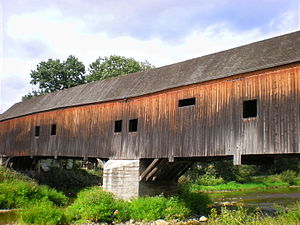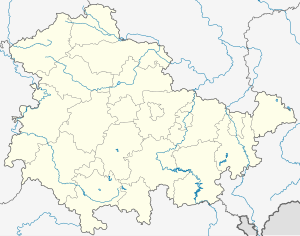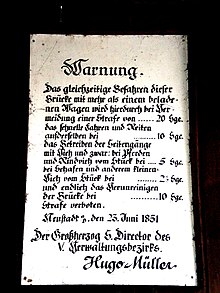Historic wooden bridge in Wünschendorf
Coordinates: 50 ° 47 ′ 41 ″ N , 12 ° 5 ′ 25 ″ E
| Historic wooden bridge in Wünschendorf | ||
|---|---|---|
| Historic wooden bridge in Wünschendorf | ||
| Convicted | Weidaer Strasse | |
| Subjugated | White magpie | |
| place | Wish village / Elster | |
| construction | covered wooden bridge | |
| overall length | 71 m | |
| width | 4.3 m | |
| Number of openings | 2 | |
| location | ||
|
|
||
The historic wooden bridge in Wünschendorf / Elster , not far from the city of Gera in Thuringia , is one of the last surviving covered wooden bridges in Germany. It is a listed building. The bridge was built in the 13th century and has since been destroyed several times. Today's bridge was built in 1786.
construction
The bridge is 71 meters long and 4.30 meters wide. Apart from the masonry foundations, the entire bridge is made of wood and covered with shingles. It rests on 40 to 50 cm thick wooden beams that were cut in the Weidaer Staatsforst. Architecturally it belongs to the covered wooden bridges. The construction is similar to that of the Hohenfichte wooden bridge , which dates from 1832.
history
The land around the wooden bridge was ruled in the Middle Ages by the Reussian noble family with ancestral castles in Gera and Weida, who maintained a large estate and the Mildenfurth monastery in Wünschendorf . On the Vitusberg a bridge crossed the 40 meter wide White Elster probably since the 11th or 12th century . During the flood of February 27, 1784 , this bridge, which had certainly been rebuilt several times, was destroyed by ice masses and melt water flowing downstream. In the following years, today's building was erected at the same location. A masterpiece of the planners and carpenters, for that time on behalf of the Saxon State Government and inclusion of compulsory labor succeeded in surrounding farmers and Gutspächtern. The bridge was damaged several times by ice masses and floods. In February 1830, the floor of the bridge collapsed after the ice crushed parts of the structure.
In 1998 the bridge was completely renovated. It is still open to traffic today, albeit with severe restrictions: Height restriction: 2.10 m, weight restriction: 2,000 kg and top speed: 10 km / h.
Awards
- The historic wooden bridge in Wünschendorf is a listed building.
- In 2007 it was voted the most beautiful bridge in Central Germany by viewers of the MDR , in front of the Göltzschtalbrücke and the Krämerbrücke in Erfurt .
Traffic situation
The historic wooden bridge is a classic bottleneck that can only be accessed in a single lane. Since there are no traffic lights, mutual understanding is required. To make matters worse, both entrances are in curve areas and the bridge is difficult to see. Since the renovation, a footpath within the bridge has been available for pedestrians.
A large bypass of Wünschendorf was planned to relieve the old wooden bridge. However, the first planning approval procedure in this regard failed in spring 2008. The construction of a bridge to relieve the historical wooden bridge parallel to it also failed due to a lack of will and the necessary money and will probably have been put on record forever.
The bridge has been rebuilt since July 2013 and opened to traffic again in September 2014. It now has a steel and concrete substructure. The passability was maintained with restrictions for vehicles up to 7.5 t, as the clearance height is limited to only 2.10 m.
literature
- Georg Dehio: Handbook of the German art monuments Thuringia . Deutscher Kunstverlag, Munich 2003, ISBN 3-422-03095-6 .
Individual evidence
- ↑ The three most beautiful bridges in Central Germany Press release from ARD (MDR) (PDF; 200 kB)
- ^ Ostthüringer Zeitung: Wooden bridge in Wünschendorf



